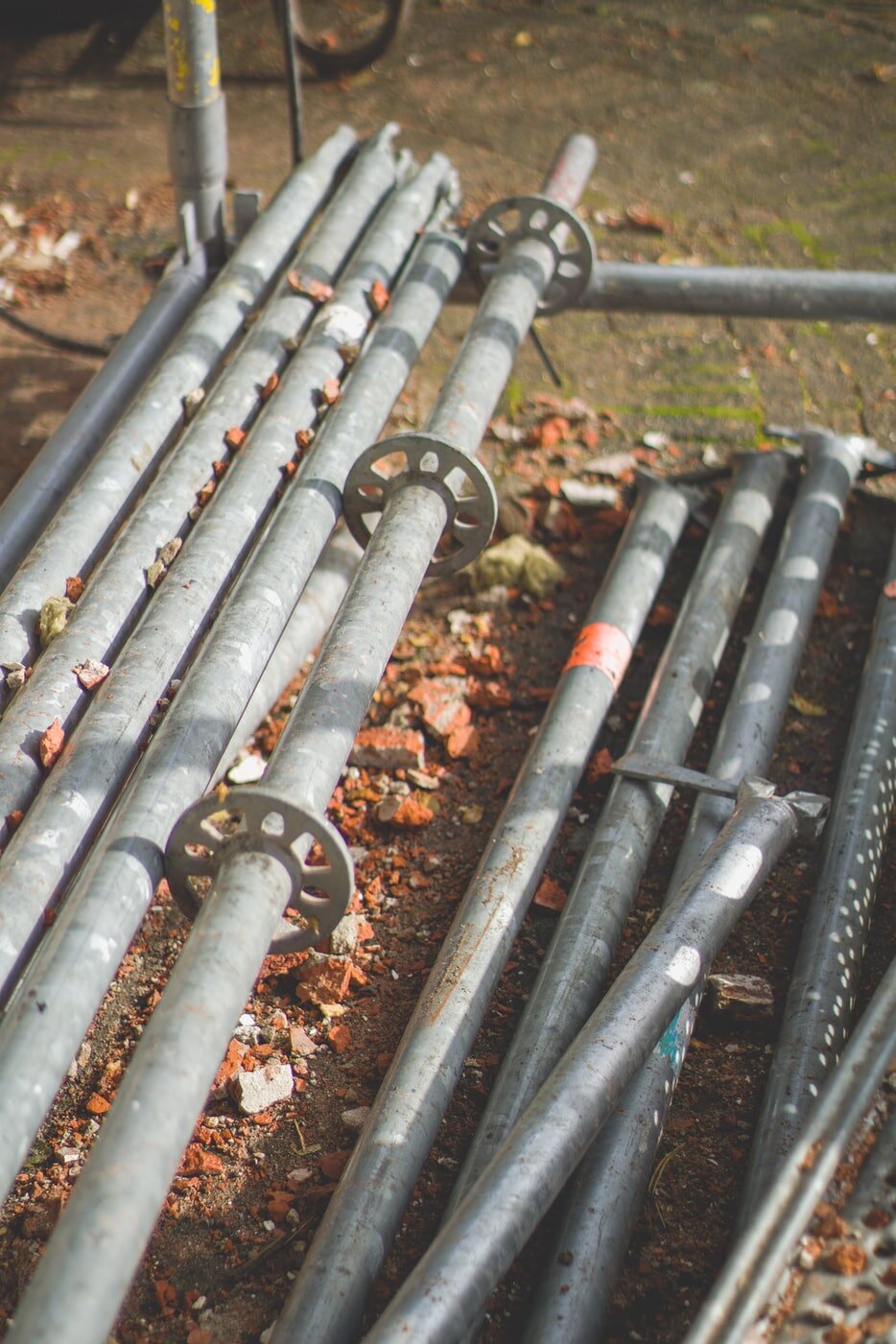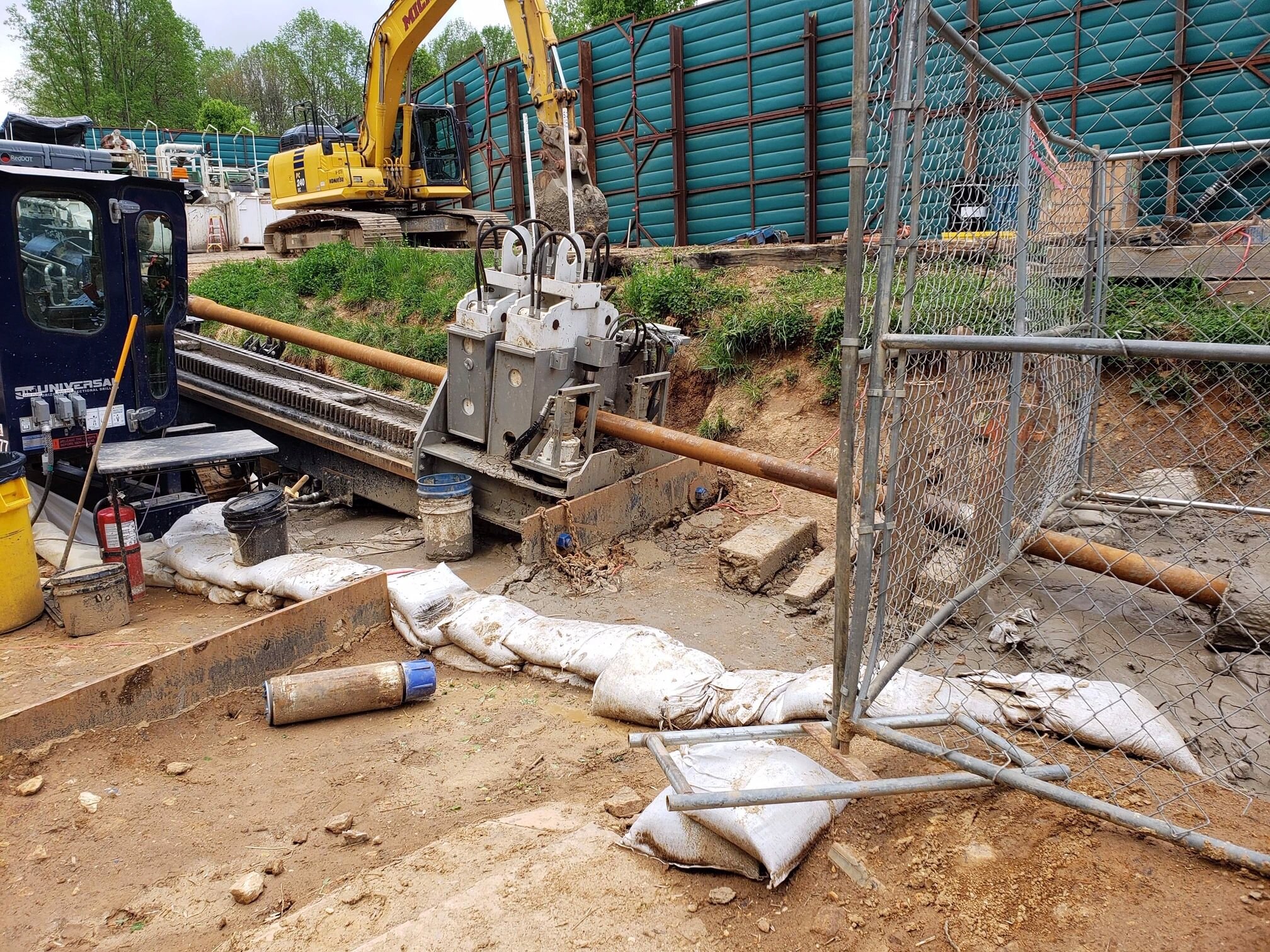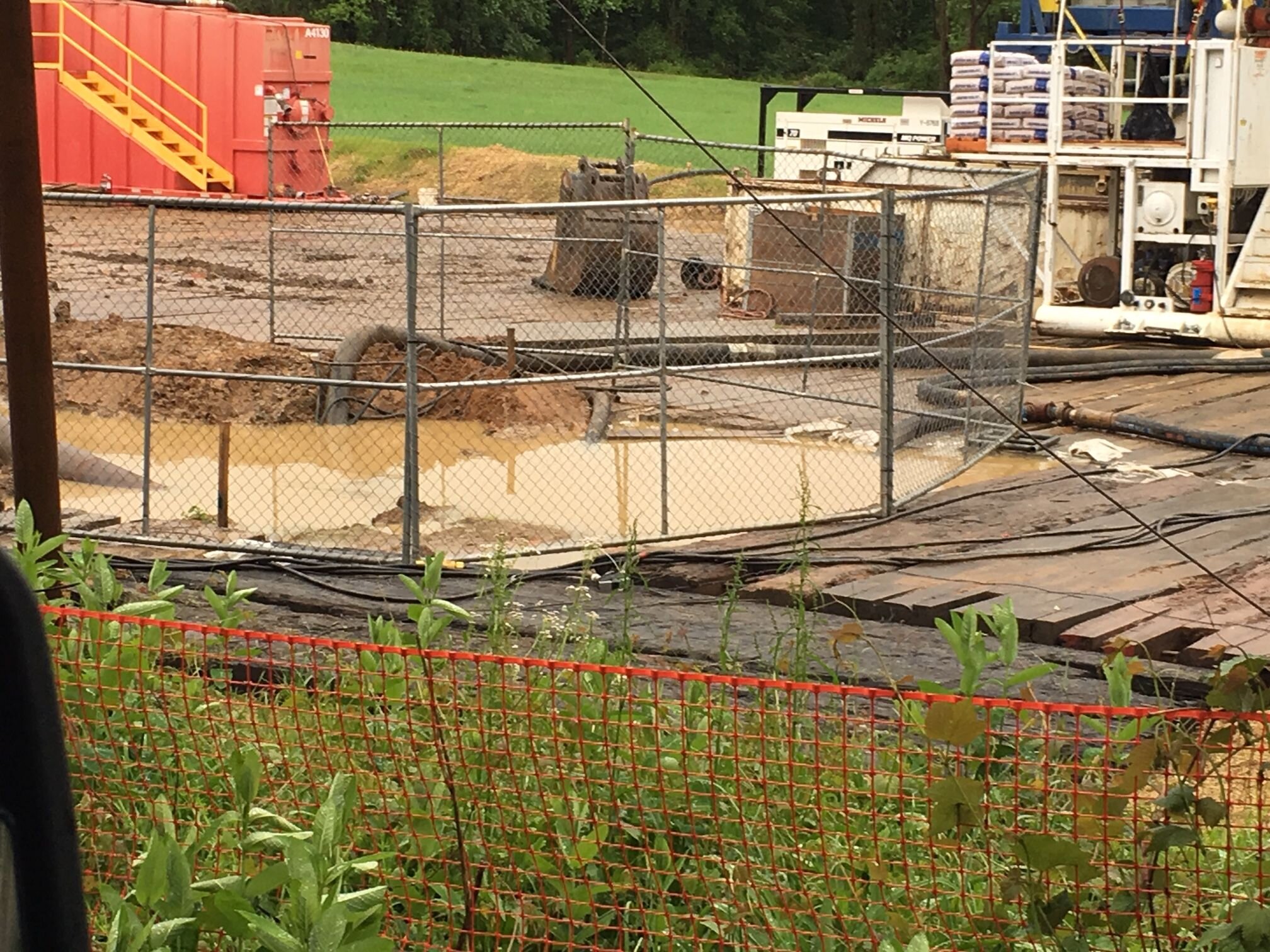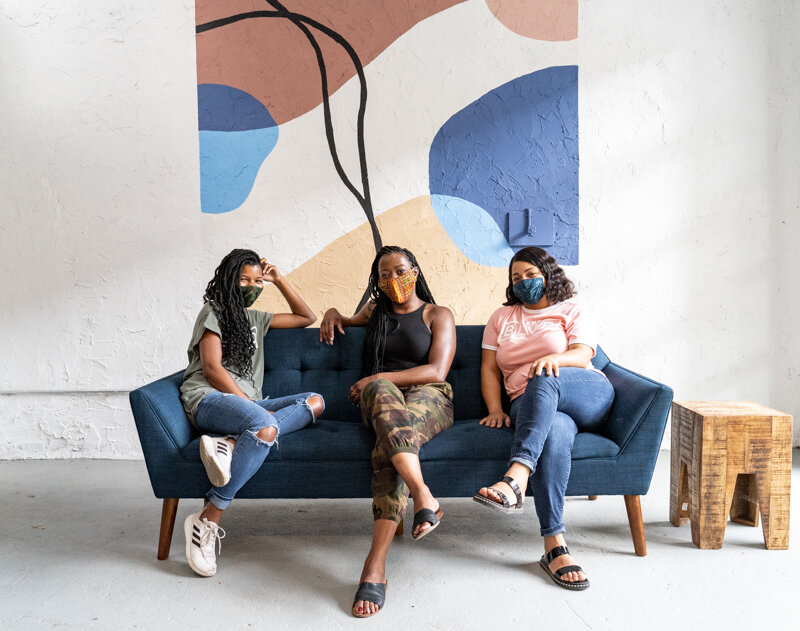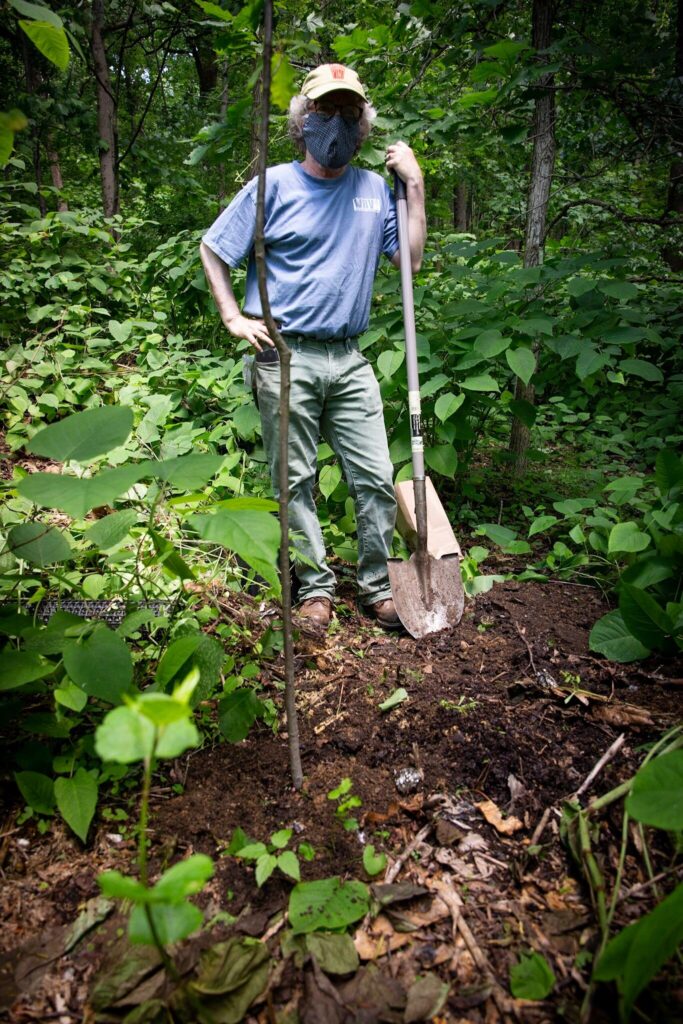Photography courtesy Lora Snyder
Troubled Waters
By Siobhan Gleason
On February 12, 2018, Delaware County residents along the Mariner East 2 pipeline route received a letter from Sunoco Pipeline LP, a subsidiary of Energy Transfer Operating LP, about a groundwater problem. Sunoco had punctured a local aquifer that residents of Edgmont Township relied on for well water. Due to a settlement with Clean Air Council, Mountain Watershed Association and the Delaware Riverkeeper Network, Sunoco was required to notify all residents within 450 feet of the drill site that the aquifer had been hit during horizontal directional drilling (HDD) activity, a method of installing a pipeline underground.
Any resident within 450 feet of the drill site who believed their water might have been contaminated during HDD was urged to contact their local Sunoco representative. In return, Sunoco offered to provide bottled water and a water buffalo (or transportable water tank) to residents as an alternative water source during the rest of the HDD construction.
“They’ll say, ‘We’re having a problem with groundwater’ and suck trucks come and suck out all the water, which is really our aquifer,” Edgmont resident Lora Snyder says. Suck trucks, otherwise known as vacuum trucks are used for removing water or slurries from different locations.
Though Sunoco offered to provide water to residents within 450 feet of the pipeline, it did not extend that offer to residents further away. Before the settlement, “they weren’t even checking anyone’s water,” Snyder says.
Sunoco may have been legally forced to provide water supplies to some residents, but oil spills and water contamination are still ongoing problems for residents in Edgmont and beyond. Since the beginning of the Mariner East 2 construction in 2017, residents have been pushing back.
The Mariner East 2 pipeline travels for 350 miles across Pennsylvania. The pipeline carries natural gas liquids extracted from the fracking sites in the Marcellus and Utica Shale regions in Western Pennsylvania, West Virginia and Eastern Ohio to the Marcus Hook Industrial Complex in Philadelphia’s neighboring Delaware County.
The pipeline will have an initial capacity of 275,000 barrels of natural gas liquids per day. These natural gas liquids are intended to be distributed and exported for plastic manufacturing in the United Kingdom. Natural gas liquids are hydrocarbons, which are composed of carbon and hydrogen. The Mariner East 2 pipeline will be carrying three natural gas liquids: butane, propane and ethane.
When natural gas liquids are not pressurized at a low temperature, they become gases. Because of this, they must be kept highly pressurized at low temperatures to maintain a liquid state, which is necessary for shipment and travel.
Since its initial construction in 2017, the Mariner East 2 pipeline has been plagued with countless environmental issues, including water contamination and sinkhole openings across Pennsylvania. The Mariner East 2 has been issued 98 violations since 2017.
Just a few incidents involving the Mariner East 2 pipeline in 2018 included the Pennsylvania Department of Environmental Protection suspending all construction on the pipeline, vandals damaging pipeline equipment in Chester County and a Chester County district attorney opening a criminal investigation into the construction. The Mariner East 2 pipeline currently faces an FBI corruption investigation and two criminal probes.
The most recent criminal probe into the pipeline was announced in March 2019. Attorney General Josh Shapiro and Delaware County District Attorney Katayoun Copeland opened a joint criminal investigation into Energy Transfer and Sunoco involving alleged criminal activity during the building of the Mariner East 2, 1 and 2x pipelines. Before Shapiro and Copeland opened their investigation in 2019, Chester County District Attorney Tom Hogan opened an investigation into construction methods used for all three pipelines.
In addition to this criminal probe, the FBI also launched an investigation in November 2019 to determine if Governor Tom Wolf had forced environmental protection staff to approve construction permits for the pipeline.
Snyder and her neighbors have been dealing with countless environmental problems ever since Sunoco began building the Mariner East 2 pipeline in Edgmont Township. Many of the issues can be traced back to horizontal directional drilling. This method is generally considered to be less environmentally impactful than open cut trench excavation, which involves digging a trench for the pipe. When open cuts are used to cross a pipeline through waterways, the water may be temporarily diverted. Because HDD is done underground, it does not divert water flow, which may seem superior to open cut trench excavation. However, HDD can be detrimental to the environment when done improperly.
During HDD, the tunnel for the pipeline and the drill bit must be kept lubricated with a slurry of water and bentonite clay (a fine absorbent clay that forms a paste when mixed with water). When the clay and water are mixed together, they are referred to as “drilling fluid.” Drilling fluid can flow through cracks or fissures in rocks and soil. It can also return to the surface and enter a waterway, where it can harm wildlife. When drilling fluid accidentally rises to the surface, it is known as an inadvertent return.
The combination of bentonite clay and water may sound nontoxic, but drilling fluid is not harmless.
“The bentonite they say is natural, nontoxic,” Snyder says, “but it’s a commercial bentonite, which if it gets in fish and amphibians, it will plug their gills and kill them.”
Sunoco has had hundreds of reported spills of drilling fluid since 2017, which have been tracked by the FracTracker Alliance, a nonprofit that uses maps and other visual tools to address the risks that oil and gas development pose to community health and the environment. The FracTracker Alliance often partners with other environmental groups to provide them with data analysis.
“As construction continued and there were incidents and inadvertent returns that were made publicly available by the Pennsylvania Department of Environmental Protection, we were able to map out those spills and keep a record of it,” Erica Jackson, community outreach and communications specialist at the FracTracker Alliance, says.
The excess sediment in drilling fluid has the potential to “adversely impact an ecosystem because there’s excess dissolved solids and sedimentation in a body of water,” Jackson says.
According to the FracTracker Alliance, the Mariner East 2 pipeline crosses 1,222 streams, 34 ponds and 708 wetlands crossings, so the environmental impact of drilling fluid can be enormous.
Drilling fluid has a similar effect on groundwater. The excess solids make water impossible to drink or use for cleaning. Drilling fluid can also contain unknown chemicals. One of Snyder’s neighbors found acetone in her water, which can be used to clean up oil spills.
“We have had three past Sunoco pipeline leaks in our township—oil and gas leaks,” Snyder says. “They’ve been doing drilling through the same areas where the leaks have occurred, probably spreading petrochemicals throughout the township.”
The continuous environmental hazards to the environment and to Pennsylvanians were what spurred groups like Mountain Watershed Association to legally challenge Sunoco. Mountain Watershed Association, Clean Air Council and the Delaware Riverkeeper Network filed three supersedeas petitions in 2018 to put a temporary halt on the Mariner East 2 pipeline construction. Two of the supersedeas were successful, and led to Sunoco, the Pennsylvania Department of Environmental Protection and the environmental organizations entering into settlements to strengthen permit conditions. Part of the settlement requires Sunoco to identify all water sources within a certain radius of a drill site by contacting all landowners near the site. This way, Sunoco would know how many wells could be impacted during HDD.
The supersedeas and the settlement were necessary because, as Melissa Marshall, community advocate at Mountain Watershed Association explains, there are no state regulations that specifically address natural gas liquids pipelines.
“It fell through the cracks of regulation. Because of the contents of this pipeline, it fell out of the oil and gas regulation framework,” Marshall says. “The only permitting schemes that were covering it were essentially basic construction permits that don’t anticipate volatile chemical impacts or major drilling projects, which this was.”
Before the settlement, the only permits that Sunoco needed were earth-moving permits and waterways- and wetlands-crossing permits, which were the same permits “you would get if you wanted to build a big back patio,” Marshall says.
In addition to the permit issues, workers for Mountain Watershed Association, Clean Air Council and the Delaware Riverkeeper Network also learned that due to a lack of regulations, rebuttable presumption does not apply to the Mariner East 2 pipeline construction.
Rebuttable presumption means that if a well or water source near an area of construction becomes contaminated, the operator doing the construction is presumed responsible for the contamination, though they may attempt to prove they are not responsible.
Because rebuttable presumption does not apply to the Mariner East 2 pipeline, if Sunoco does not claim responsibility for contamination, residents may have no way of proving Sunoco was responsible, especially if they do not have water samples from their wells before construction began.
The lack of rebuttable presumption “means no one has the right to water-replacement supplies or compensation,” Marshall says. “The only way they could get that would be through an enormously expensive legal process.”
According to Marshall, any residents attempting to prove Sunoco’s responsibility for contamination would need to hire hydrogeologists, engineers and other experts to testify on their behalf. She estimates this would cost “around a half a million dollars to start with.”
Since most people cannot afford that legal pathway, they often do not have the power to take on the company. “A lot of community members have been left with whatever Sunoco will offer them,” Marshall says.
Through her work with residents impacted by the pipeline, Marshall has noticed that what Sunoco offers a landowner varies widely. In some instances, residents have been offered a water buffalo if they agree to sign a liability waiver.
Other times, Sunoco has offered nothing at all.
Patrick Robinson, a resident of Indiana County, was not offered a water buffalo because he would not agree to signing a liability waiver. His well lost 37 gallons of water and went dry during Mariner East 2 construction.
“They wanted me to sign a waiver saying it wasn’t their fault for the water loss. Since I wouldn’t do that, they hung me out to dry,” Robinson says.
Robinson believes his choice not to sign the waiver was the correct one because he can communic
ate with the media and groups like Mountain Watershed Association.
A major concern for environmental groups and residents alike is that the Mariner East 2 pipeline is only the first in a wave of new natural gas liquids pipelines, which will continue to contaminate water across Pennsylvania.
As Marshall says, “there were no anticipatory laws” for the Mariner East 2 pipeline. However, pushing back against it has given groups like Mountain Watershed Association the legal tools they need to challenge future pipelines as they begin construction in the near future. It is never too soon to prepare for the next pipeline that will snake across the state.
Energy Transfer Partners did not respond to a request for comment in time for publication.

